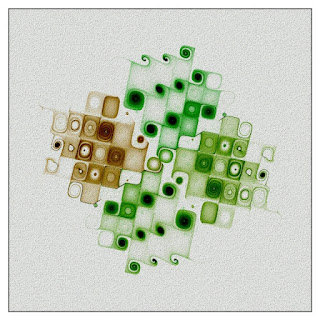Stay before my eyes with curiosity.
The interesting artworks by chance.
A generative art made with Processing on Java programming language. It draws an interesting shape with the Vector field method using one of the generated formulae.
When I played with my code in this article, I found a formula that creates an interesting shape.
In Java, how can I write a generative formula?
https://www.deconbatch.com/2019/09/in-java-how-can-i-write-generative.html
I picked that formula and draw a shape on the background that I learned from @ky0ju_art.
つぶやきProcessingでプロトタイプを作成→気に入ったものを発展させる— ky0ju (@ky0ju_art) November 11, 2019
というフローでモチベーションが保てる。ありあがとう、つぶやきProcessing。https://t.co/gMhrFWeckv pic.twitter.com/aVcJXyLhSr
The 'Processing' example code.
This code does not display any images on the screen but generates image files in frames directory.
Please feel free to use this example code under the terms of the GPL. To see other works based on my code is my pleasure. And my honor.
/**
* Dust in the Wind.
* draws an interesting shape with the Vector field method using one of the generated formulae.
*
* @author @deconbatch
* @version 0.1
* Processing 3.2.1
* created 2019.11.16
*/
void setup() {
size(980, 980);
colorMode(HSB, 360, 100, 100, 100);
rectMode(CENTER);
smooth();
noLoop();
}
void draw() {
int frmMax = 3; // draw 3 frames
int rotateMax = 2; // draw 2 times with 180 degree rotation
int imgMax = 2; // draw 2 pattern per one frame
float initHue = random(360.0);
translate(width * 0.5, height * 0.5);
for (int frmCnt = 0; frmCnt < frmMax; frmCnt++) {
noiseSeed(frmCnt * 10);
blendMode(BLEND);
drawCanvas(initHue + 240.0);
blendMode(DIFFERENCE);
noStroke();
noFill();
pushMatrix();
rotate(random(PI));
for (int rotateCnt = 0; rotateCnt < rotateMax; rotateCnt++) {
initHue += 30.0;
rotate(TWO_PI / rotateMax);
for (int imgCnt = 1; imgCnt <= imgMax; imgCnt++) {
float imgRatio = map(imgCnt, 1, imgMax, 0.0, 1.0);
int plotMax = floor(map(imgRatio, 0.0, 1.0, 600.0, 900.0));
float plotDiv = map(imgRatio, 0.0, 1.0, 0.001, 0.002);
float plotMult = map(imgRatio, 0.0, 1.0, 5.0, 15.0);
float initDiv = map(imgRatio, 0.0, 1.0, 0.005, 0.015);
float baseHue = initHue + map(imgRatio, 0.0, 1.0, 0.0, 30.0);
float baseBri = 1.0;
float baseSiz = map(imgRatio, 0.0, 1.0, 0.7, 0.4);
drawVector(plotMax, plotDiv, plotMult, initDiv, baseHue, baseBri, baseSiz);
}
}
popMatrix();
casing();
saveFrame("frames/" + String.format("%04d", frmCnt + 1) + ".png");
}
exit();
}
/**
* drawVector : draw vector field
* @param _plotMax : dot plot count per initial coordinates.
* @param _plotDiv : dot plot increments.
* @param _plotMult : curvature, bigger value means large curvature.
* @param _initDiv : initial coordinates increments.
* @param _baseHue : dot hue.
* @param _baseBri : dot brightness.
* @param _baseSiz : dot size.
*/
private void drawVector(int _plotMax, float _plotDiv, float _plotMult, float _initDiv, float _baseHue, float _baseBri, float _baseSiz) {
// draw vector field
for (float xInit = -0.55; xInit <= 0.55; xInit += _initDiv) {
for (float yInit = -0.55; yInit <= 0.55; yInit += _initDiv) {
float xPoint = xInit;
float yPoint = yInit;
for (int plotCnt = 0; plotCnt < _plotMax; plotCnt++) {
float plotRatio = map(plotCnt, 0, _plotMax, 0.0, 1.0);
float eHue = _baseHue + plotRatio * 30.0 + floor(((xInit * yInit) * 10000.0) % 4.0) * 10.0;
float eSat = map(sin(PI * plotRatio), 0.0, 1.0, 0.0, 60.0);
float eBri = _baseBri * (0.5 + sin(PI * plotRatio));
float eSiz = _baseSiz * (0.5 + sin(PI * plotRatio));
float xPrev = xPoint;
float yPrev = yPoint;
// I found this formula by chance. I don't know all elements are necessary.
float clc = cos(yPrev) * (sin(xPrev) + exp(xPrev) - atan(xPrev)) * log(yPrev) - (exp(yPrev) - cos(yPrev)) * exp(xPrev) - (sin(xPrev) % pow(yPrev, 2));
// Add variation of shape with the Perlin noise.
float noiseDiv = map(noise(xPrev * 1.0, yPrev * 1.0), 0.0, 1.0, 0.5, 1.5);
xPoint += _plotDiv * cos((atan2(xPrev, clc) + TWO_PI * yPrev) * _plotMult * noiseDiv);
yPoint += _plotDiv * sin((atan2(yPrev, clc) + TWO_PI * xPrev) * _plotMult * noiseDiv);
fill(eHue % 360.0, eSat, eBri, 100.0);
ellipse(xPoint * width * 0.45, yPoint * height * 0.45, eSiz, eSiz);
}
}
}
}
/**
* drawCanvas : draw sand wall
* @param _baseHue : sand color.
*/
void drawCanvas(float _baseHue) {
background(0.0, 0.0, 90.0, 100.0);
for (int x = 0; x < width * 0.5; x += 2) {
for (int y = 0; y < height * 0.5; y += 2) {
float pSize = random(0.5, 1.0);
float pDiv = random(-2.0, 2.0);
float pSat = 0.0;
if ((x + y) % 3 == 0) {
pSat = 80.0;
}
strokeWeight(pSize);
stroke(_baseHue % 360.0, pSat, 30.0, 70.0);
point(x + pDiv, y + pDiv);
point(-x + pDiv, y + pDiv);
point(x + pDiv, -y + pDiv);
point(-x + pDiv, -y + pDiv);
}
}
}
/**
* casing : draw fancy casing
*/
private void casing() {
blendMode(BLEND);
fill(0.0, 0.0, 0.0, 0.0);
strokeWeight(54.0);
stroke(0.0, 0.0, 0.0, 100.0);
rect(0.0, 0.0, width, height);
strokeWeight(50.0);
stroke(0.0, 0.0, 100.0, 100.0);
rect(0.0, 0.0, width, height);
noStroke();
noFill();
}
/*
Copyright (C) 2019- deconbatch
This program is free software: you can redistribute it and/or modify
it under the terms of the GNU General Public License as published by
the Free Software Foundation; either version 3 of the License, or
(at your option) any later version.
This program is distributed in the hope that it will be useful,
but WITHOUT ANY WARRANTY; without even the implied warranty of
MERCHANTABILITY or FITNESS FOR A PARTICULAR PURPOSE. See the
GNU General Public License for more details.
You should have received a copy of the GNU General Public License
along with this program. If not, see <http://www.gnu.org/licenses/>
*/
Yet another example images.










